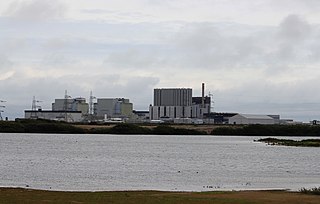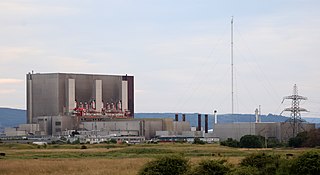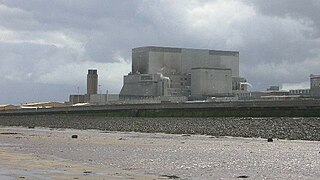Related Research Articles

The Advanced Gas-cooled Reactor (AGR) is a type of nuclear reactor designed and operated in the United Kingdom. These are the second generation of British gas-cooled reactors, using graphite as the neutron moderator and carbon dioxide as coolant. They have been the backbone of the UK's nuclear power generation fleet since the 1980s.

Great British Nuclear (GBN), formerly British Nuclear Fuels Ltd (BNFL), is a nuclear energy and fuels company owned by the UK Government. It is a non-departmental public body sponsored by the Department for Energy Security and Net Zero.

The Dungeness nuclear power stations are a pair of non-operational nuclear power stations located on the Dungeness headland in the south of Kent, England.
British Energy was the UK's largest electricity generation company by volume, before being taken over by Électricité de France (EDF) in 2009. British Energy operated eight former UK state-owned nuclear power stations and one coal-fired power station.

Électricité de France SA, commonly known as EDF, is a French multinational electric utility company owned by the government of France. Headquartered in Paris, with €139.7 billion in sales in 2023, EDF operates a diverse portfolio of at least 120 gigawatts of generation capacity in Europe, South America, North America, Asia, the Middle East, and Africa.

The EPR is a Generation III+ pressurised water reactor design. It has been designed and developed mainly by Framatome and Électricité de France (EDF) in France, and by Siemens in Germany. In Europe this reactor design was called European Pressurised Reactor, and the internationalised name was Evolutionary Power Reactor, but is now simply named EPR.

The Calvert Cliffs Nuclear Power Plant (CCNPP) is a nuclear power plant located on the western shore of the Chesapeake Bay near Lusby, Calvert County, Maryland in the Mid-Atlantic United States. It is the only nuclear power plant in the state of Maryland.

Hartlepool nuclear power station is a nuclear power station situated on the northern bank of the mouth of the River Tees, 2.5 mi south of Hartlepool in County Durham, North East England. The station has a net electrical output of 1,185 megawatts, which is 2% of Great Britain's peak electricity demand of 60 GW. Electricity is produced through the use of two advanced gas-cooled reactors (AGR). Hartlepool was only the third nuclear power station in the United Kingdom to use AGR technology. It was also the first nuclear power station to be built close to a major urban area.

Since the mid 1980s, the largest source of electricity in France has been nuclear power, with a generation of 379.5 TWh in 2019 and a total electricity production of 537.7 TWh. In 2018, the nuclear share was 71.67%, the highest percentage in the world.
Nuclear power in the United Kingdom generated 16.1% of the country's electricity in 2020. As of August 2022, the UK has 9 operational nuclear reactors at five locations, producing 5.9 GWe. It also has nuclear reprocessing plants at Sellafield and the Tails Management Facility (TMF) operated by Urenco in Capenhurst.

EDF Energy is a British integrated energy company, wholly owned by the French state-owned EDF, with operations spanning electricity generation and the sale of natural gas and electricity to homes and businesses throughout the United Kingdom. It employs 11,717 people, and handles 5.22 million business and residential customer accounts.
Nuclear decommissioning is the process leading to the irreversible complete or partial closure of a nuclear facility, usually a nuclear reactor, with the ultimate aim at termination of the operating licence. The process usually runs according to a decommissioning plan, including the whole or partial dismantling and decontamination of the facility, ideally resulting in restoration of the environment up to greenfield status. The decommissioning plan is fulfilled when the approved end state of the facility has been reached.
Nuclear Electric was a nuclear power generation company in the United Kingdom. It was formed in 1990 as part of the privatisation process of the UK Electricity Supply Industry.

Hinkley Point B nuclear power station was a nuclear power station near Bridgwater, Somerset, on the Bristol Channel coast of south west England. It was the first commercial Advanced Gas Cooled reactor to generate power to the National Grid in 1976 and shares its design with sister station Hunterston B nuclear power station. It ceased operations permanently on 1 August 2022.

The Sizewell nuclear site consists of two nuclear power stations, one of which is still operational, located near the small fishing village of Sizewell in Suffolk, England. Sizewell A, with two Magnox reactors, is now in the process of being decommissioned. Sizewell B has a single pressurised water reactor (PWR) and is the UK's newest nuclear power station. A third power station, to consist of twin EPR reactors, is planned to be built as Sizewell C.

Nuclear power construction costs have varied significantly across the world and in time. Large and rapid increases in cost occurred during the 1970s, especially in the United States. Recent cost trends in countries such as Japan and Korea have been very different, including periods of stability and decline in costs.
Nuclear power in the European Union accounted for approximately 26% of total electricity production in 2019 and nearly half of low-carbon energy production across the EU.

Hinkley Point C nuclear power station (HPC) is a two-unit, 3,200 MWe EPR nuclear power station under construction in Somerset, England.
Moorside nuclear power station is proposed for a site near Sellafield, in Cumbria, England. The original plan by NuGeneration, a British subsidiary of Toshiba-owned Westinghouse Electric Company, had the station coming online from 2024 with 3.4 GW of new nuclear capacity, from three AP1000 reactors. Work up to 2018 would include acquiring the site licence, the development consent order, and other required permits and permissions to start work. Site preparation was to take two years, up to 2020.

Sizewell C nuclear power station is a project to construct a 3,200 MWe nuclear power station with two EPR reactors in Suffolk, England. The project was proposed by a consortium of EDF Energy and China General Nuclear Power Group, which own 80% and 20% of the project respectively. In 2022, UK Government announced a buy-out to allow for the exit of CGN from the project and forming a 50% stake with EDF, though EDF expect this to fall below 20% following anticipated external investment. The power station is expected to meet up to 7% of the UK's demand if it comes into service.
References
- ↑ "DECC's Delivery Partners". Department of Energy and Climate Change. Archived from the original on 2012-03-04. Retrieved 2011-09-25.
- ↑ "About the Fund". Nuclear Liabilities Fund.
- ↑ "Purpose". Nuclear Liabilities Fund.
- ↑ "History". Nuclear Liabilities Fund.
- ↑ "Government cuts stake in British Energy to fund decommissioning". The Independent.[ dead link ]
- ↑ "EDF completes takeover of British Energy". GreenWise.